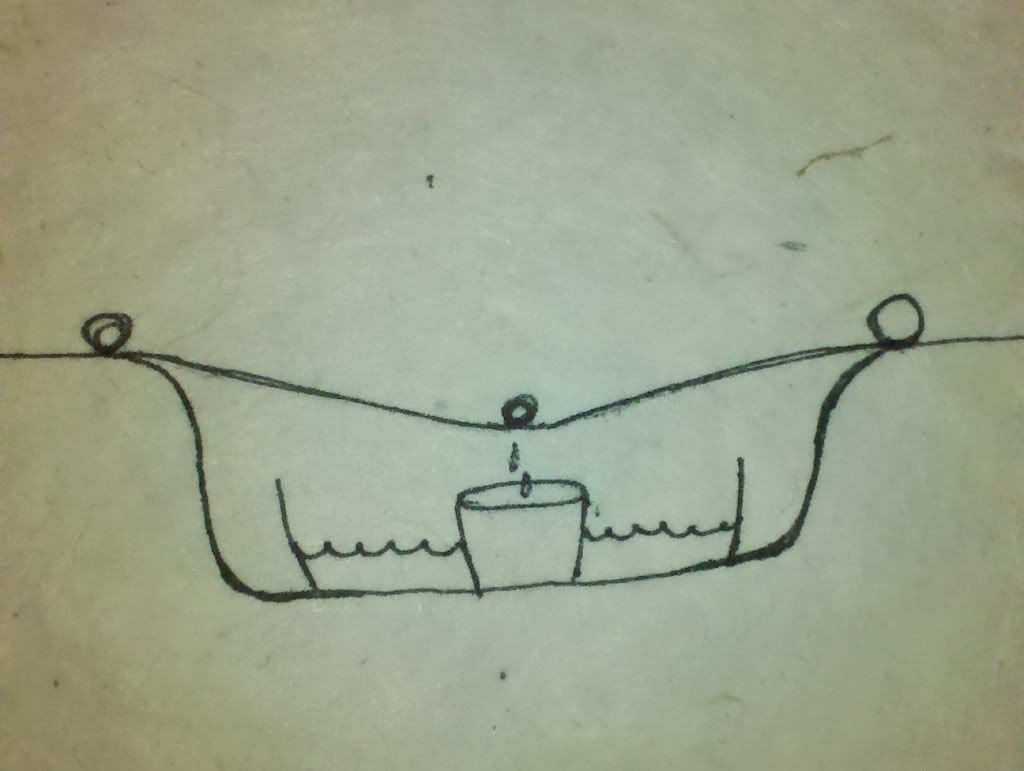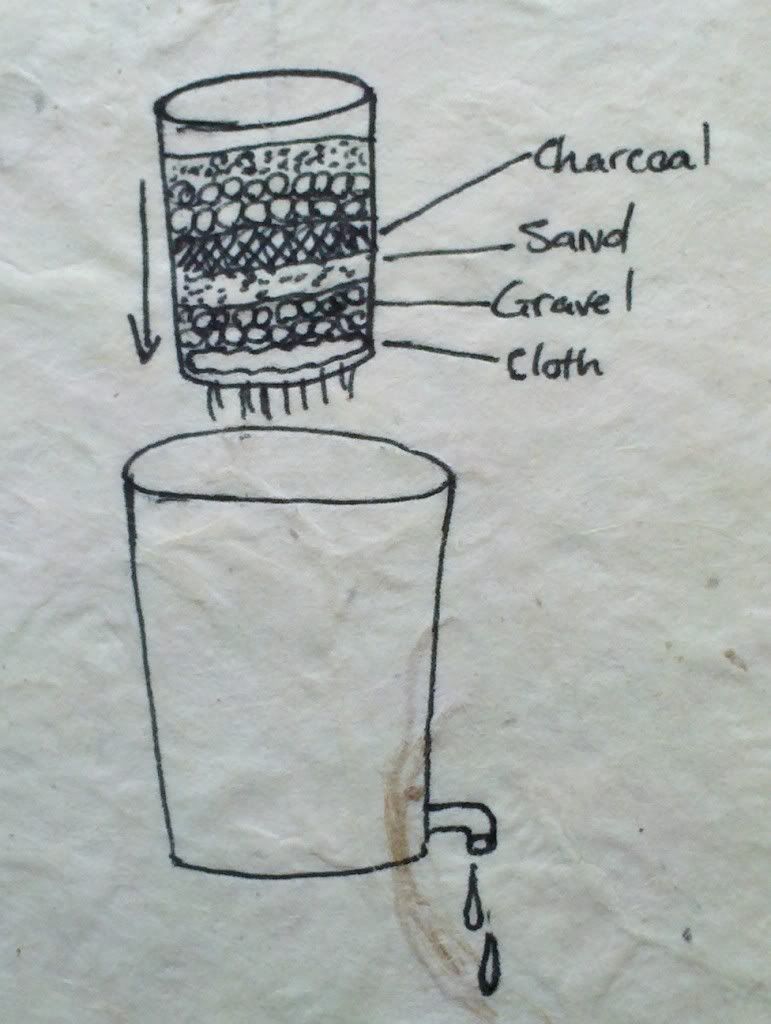Now to purify. Boiling is always best. It desroys all pathogens, and evaporates many chemicals. Bringing water to a rolling boil will nearly always make it safe to drink. Boiling can also be used to make salt water drinkable. By building a simple still you can catch the condensed water that boils off, while leaving the salt behind. This method is also effective if filtration isn't possible, as any dirt or debris would be left in the boil pot as well. The simplest of stills would be a plate or a piece of metal suspended over a pot of boiling water. Tip the plate down towards another container and the steam will condense and drip down. A simpler way of doing this is to throw your t-shirt over a pot of boiling water, let it absorb the steam and wring it out.
Pasteurization is a fairly reliable method as well, but I would only recommend it if you dont have anything to boil in. To pasteurize, heat the water to 160 degrees and maintain that temp for about a half hour. This should kill anything in there. You can do this in a plastic container by placing it near your fire and slowly bringing up the temperature.
You can also purify water with bleach, I wouldnt recommend doing this unless you had no other choice. Really it isn't much different than how your tap water is purified in many places. Take your water 1 gallon at a time and add 1 tablespoon of bleach at a time, mix and let sit for about 20 minutes. If the mixture begins to smell very slightly like bleach, you're done. Let it sit an additional hour, and drink. By this point the chlorine has killed off all the bacteria, and hopefully some of it has evaporated enough so that it tastes ok.
 Solar stills are about the most effective, they require no energy to run, and once you're done building it, it doesn't require much work. Dig a hole a couple feet deep, and a few feet wide. (size depends on the containers you're using) Place a large, shallow container (or line the bottom with a black garbage bag) and fill it with your tainted water. Place a smaller container in the middle. (make sure it doesnt float) Cover the hole with a clear plastic bag. Line the edges with rocks to make it somewhat airtight, and place a small pebble in the center of the plastic above your cup. The sun heats the still like a greenhouse, the water evaporates and condenses on the cooler clear plastic. It then runs down the the low spot where you placed the pebble and drips into the cup. If you have a long piece of tubing you can place it in the cup and run it outside the still so you can drink without disturbing the plastic. This method is also effective for purifying urine if there is no water available.
Solar stills are about the most effective, they require no energy to run, and once you're done building it, it doesn't require much work. Dig a hole a couple feet deep, and a few feet wide. (size depends on the containers you're using) Place a large, shallow container (or line the bottom with a black garbage bag) and fill it with your tainted water. Place a smaller container in the middle. (make sure it doesnt float) Cover the hole with a clear plastic bag. Line the edges with rocks to make it somewhat airtight, and place a small pebble in the center of the plastic above your cup. The sun heats the still like a greenhouse, the water evaporates and condenses on the cooler clear plastic. It then runs down the the low spot where you placed the pebble and drips into the cup. If you have a long piece of tubing you can place it in the cup and run it outside the still so you can drink without disturbing the plastic. This method is also effective for purifying urine if there is no water available.
 Solar stills are about the most effective, they require no energy to run, and once you're done building it, it doesn't require much work. Dig a hole a couple feet deep, and a few feet wide. (size depends on the containers you're using) Place a large, shallow container (or line the bottom with a black garbage bag) and fill it with your tainted water. Place a smaller container in the middle. (make sure it doesnt float) Cover the hole with a clear plastic bag. Line the edges with rocks to make it somewhat airtight, and place a small pebble in the center of the plastic above your cup. The sun heats the still like a greenhouse, the water evaporates and condenses on the cooler clear plastic. It then runs down the the low spot where you placed the pebble and drips into the cup. If you have a long piece of tubing you can place it in the cup and run it outside the still so you can drink without disturbing the plastic. This method is also effective for purifying urine if there is no water available.
Solar stills are about the most effective, they require no energy to run, and once you're done building it, it doesn't require much work. Dig a hole a couple feet deep, and a few feet wide. (size depends on the containers you're using) Place a large, shallow container (or line the bottom with a black garbage bag) and fill it with your tainted water. Place a smaller container in the middle. (make sure it doesnt float) Cover the hole with a clear plastic bag. Line the edges with rocks to make it somewhat airtight, and place a small pebble in the center of the plastic above your cup. The sun heats the still like a greenhouse, the water evaporates and condenses on the cooler clear plastic. It then runs down the the low spot where you placed the pebble and drips into the cup. If you have a long piece of tubing you can place it in the cup and run it outside the still so you can drink without disturbing the plastic. This method is also effective for purifying urine if there is no water available.Procurement can be a challenge in nature but there are tons of opportunities in an urban area. The easiest being your hot water heater. I touched on it in my last post. Simply shut off the water coming in, (there is most likely a valve at the top) and drain from the bottom. Simple as that, you dont even need to turn off the valve at the top onless you're worried about contaminated water in the taps. (for example in a widespread flood scenario or nuclear disaster)Another easy one is the toilet, by that I mean the tank at the top, not in the bowl. In a dire emergency you could use the water in the bowl, but it would need to be sanitized first.
Simple rain collection can be your best bet for long term survival. If you own a house, use your gutters, clean them well and the water should be good to drink as is. If you have a tarp available, use your imagination and build a collector.

Good info. I'm curious about finding useful materials in a woodland environment.
ReplyDelete